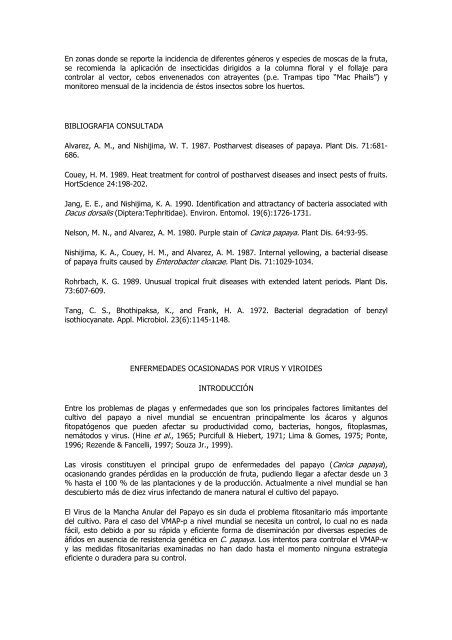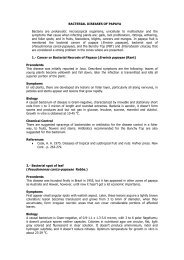clasificación de enfermedades según su agente causal
clasificación de enfermedades según su agente causal
clasificación de enfermedades según su agente causal
Create successful ePaper yourself
Turn your PDF publications into a flip-book with our unique Google optimized e-Paper software.
En zonas don<strong>de</strong> se reporte la inci<strong>de</strong>ncia <strong>de</strong> diferentes géneros y especies <strong>de</strong> moscas <strong>de</strong> la fruta,<br />
se recomienda la aplicación <strong>de</strong> insecticidas dirigidos a la columna floral y el follaje para<br />
controlar al vector, cebos envenenados con atrayentes (p.e. Trampas tipo “Mac Phails”) y<br />
monitoreo men<strong>su</strong>al <strong>de</strong> la inci<strong>de</strong>ncia <strong>de</strong> éstos insectos sobre los huertos.<br />
BIBLIOGRAFIA CONSULTADA<br />
Alvarez, A. M., and Nishijima, W. T. 1987. Postharvest diseases of papaya. Plant Dis. 71:681-<br />
686.<br />
Couey, H. M. 1989. Heat treatment for control of postharvest diseases and insect pests of fruits.<br />
HortScience 24:198-202.<br />
Jang, E. E., and Nishijima, K. A. 1990. I<strong>de</strong>ntification and attractancy of bacteria associated with<br />
Dacus dorsalis (Diptera:Tephritidae). Environ. Entomol. 19(6):1726-1731.<br />
Nelson, M. N., and Alvarez, A. M. 1980. Purple stain of Carica papaya. Plant Dis. 64:93-95.<br />
Nishijima, K. A., Couey, H. M., and Alvarez, A. M. 1987. Internal yellowing, a bacterial disease<br />
of papaya fruits caused by Enterobacter cloacae. Plant Dis. 71:1029-1034.<br />
Rohrbach, K. G. 1989. Unu<strong>su</strong>al tropical fruit diseases with exten<strong>de</strong>d latent periods. Plant Dis.<br />
73:607-609.<br />
Tang, C. S., Bhothipaksa, K., and Frank, H. A. 1972. Bacterial <strong>de</strong>gradation of benzyl<br />
isothiocyanate. Appl. Microbiol. 23(6):1145-1148.<br />
ENFERMEDADES OCASIONADAS POR VIRUS Y VIROIDES<br />
INTRODUCCIÓN<br />
Entre los problemas <strong>de</strong> plagas y enfermeda<strong>de</strong>s que son los principales factores limitantes <strong>de</strong>l<br />
cultivo <strong>de</strong>l papayo a nivel mundial se encuentran principalmente los ácaros y algunos<br />
fitopatógenos que pue<strong>de</strong>n afectar <strong>su</strong> productividad como, bacterias, hongos, fitoplasmas,<br />
nemátodos y virus. (Hine et al., 1965; Purcifull & Hiebert, 1971; Lima & Gomes, 1975; Ponte,<br />
1996; Rezen<strong>de</strong> & Fancelli, 1997; Souza Jr., 1999).<br />
Las virosis constituyen el principal grupo <strong>de</strong> enfermeda<strong>de</strong>s <strong>de</strong>l papayo (Carica papaya),<br />
ocasionando gran<strong>de</strong>s pérdidas en la producción <strong>de</strong> fruta, pudiendo llegar a afectar <strong>de</strong>s<strong>de</strong> un 3<br />
% hasta el 100 % <strong>de</strong> las plantaciones y <strong>de</strong> la producción. Actualmente a nivel mundial se han<br />
<strong>de</strong>scubierto más <strong>de</strong> diez virus infectando <strong>de</strong> manera natural el cultivo <strong>de</strong>l papayo.<br />
El Virus <strong>de</strong> la Mancha Anular <strong>de</strong>l Papayo es sin duda el problema fitosanitario más importante<br />
<strong>de</strong>l cultivo. Para el caso <strong>de</strong>l VMAP-p a nivel mundial se necesita un control, lo cual no es nada<br />
fácil, esto <strong>de</strong>bido a por <strong>su</strong> rápida y eficiente forma <strong>de</strong> diseminación por diversas especies <strong>de</strong><br />
áfidos en ausencia <strong>de</strong> resistencia genética en C. papaya. Los intentos para controlar el VMAP-w<br />
y las medidas fitosanitarias examinadas no han dado hasta el momento ninguna estrategia<br />
eficiente o dura<strong>de</strong>ra para <strong>su</strong> control.



